Homemade sauerkraut is so much better than the kind that comes from the grocery store. It’s crunchy, tart, and perfect for adding to salads, sandwiches, or eating just by itself. All you need to make it is cabbage, salt, and a jar to ferment it in. Before long, you’ll be hooked on this beneficial probiotic food too!
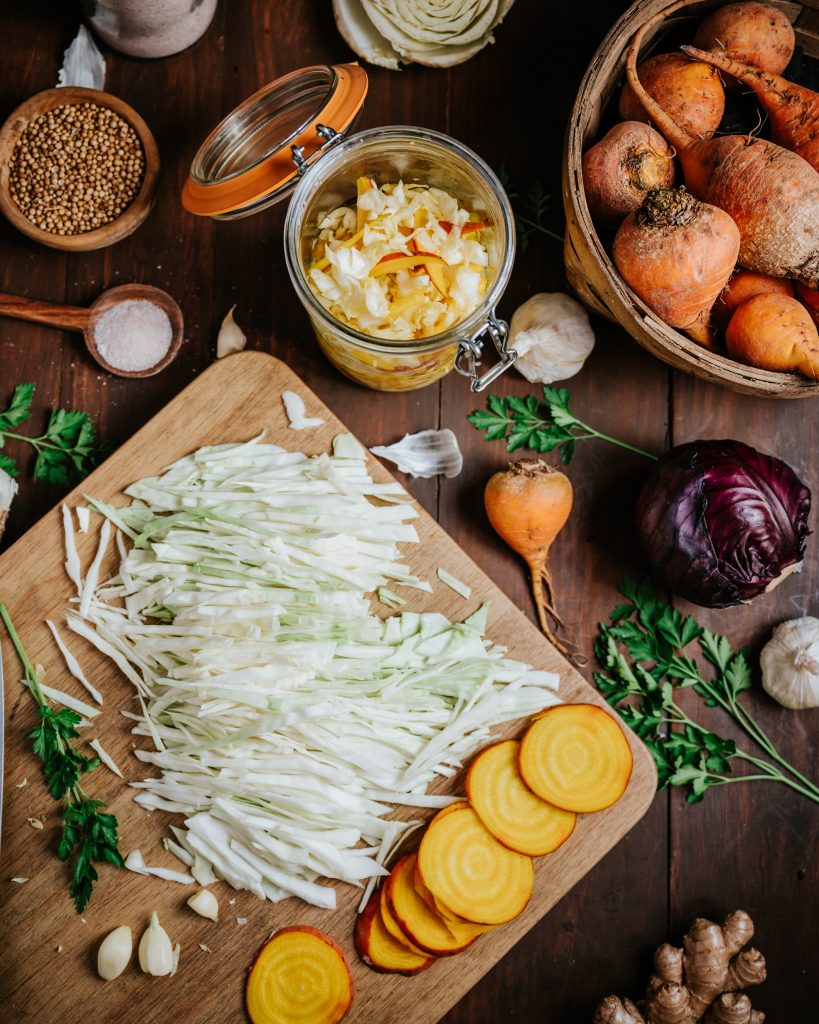
What is Sauerkraut?
Sauerkraut is fermented cabbage with a distinctive sour flavor and crips texture. It’s one of the easiest fermented foods to make, so it’s a great place to start for those new to fermentation.
All you need to get started are two ingredients — cabbage and salt. And a little time and patience before you can enjoy your kraut.
You simply combine shredded cabbage with salt and massage it in to extract the juice from the cabbage. Then, you pack it into a container — a mason jar will do just fine for small batches — to submerge it under the brine.
The salt draws the liquid from the cabbage, creating a salty, acidic brine. The cabbage stays submerged in the brine for several days to weeks, and it slowly ferments and transforms into the crunchy, tart, delicious condiment we know and love.
What Are The Health Benefits Of Sauerkraut?
Sauerkraut is a highly nutritious food that is particularily healing for the digestive system. Raw sauerkraut is rich in lactobacillus, so it’s especially beneficial for restoring healthy gut flora.
It also contains a range of minerals, vitamins A, B, C, K2, and fiber. Vitamin K2, also called menaquinone, is particularily important, because it’s often lacking in diets which include little fermented foods.
Sauerkraut contains an impressive 2.75 micrograms of Vitamin K2 per half-cup!
Vitamin K2 is important for bone health, to help prevent osteoporosis, and to build bone density. It also helps prevent calcium deposits in the arteries and contributes towards heart health.
According to one study, people who consumed most vitamin K2 through vitamin K2 rich foods (mainly fermented foods and meat from animals fed K3), had a 50% reduced risk of arterial calcification and also a 50% risk reduction for cardiovascular events during the study period.
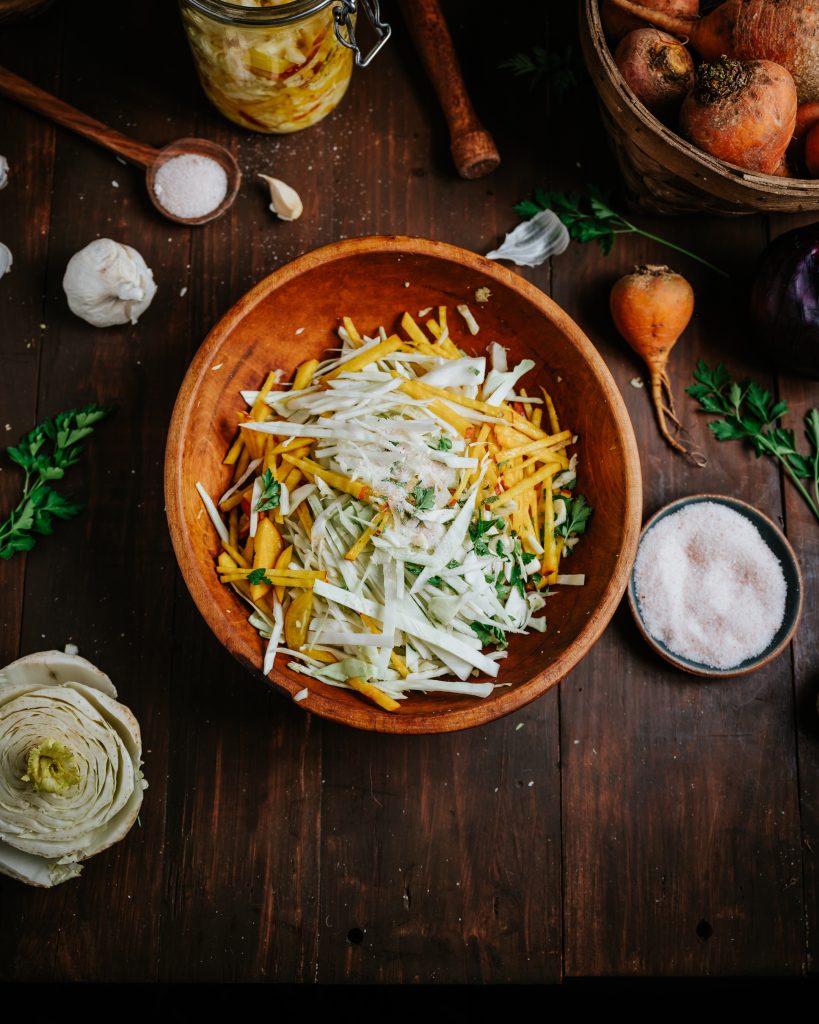
How Is Sauerkraut Fermented?
Sauerkraut is fermented by a process called lacto-fermentation. The beneficial bacteria are present on the surface of the cabbage (and all fresh vegetables and fruits). Lactobacillus is one of those bacteria. They are also the same bacteria found in yogurt, cheese, and many other cultured foods.
When the cabbage is submerged in the brine, the bacteria convert the sugars found in cabbage into lactic acid. This acts as a natural preservative that inhibits the growth of harmful bacteria by creating an acidic environment.
This is why it’s important to keep the cabbage submerged under the brine, so the lactobacillus can thrive and produce lactic acid. This requires an anaerobic environment.
Is Fermented Sauerkraut Safe?
Lacto-fermentation has been used for over 2000 years to preserve seasonal produce beyond its natural shelf life. The fermentation process is reliable and safe and the fermented sauerkraut can be kept at cool temperatures for months.
Historically, fermented foods would be kept in the root cellar (around 55-57°F) along with canned foods and produce. Nowadays, most of us without root cellars store fermented foods in the fridge.
In addition to preserving the cabbage, the fermentation process also transforms the cabbage into a healthy, tasty food that contains beneficial probiotics — similar to the probiotics found in yogurt.
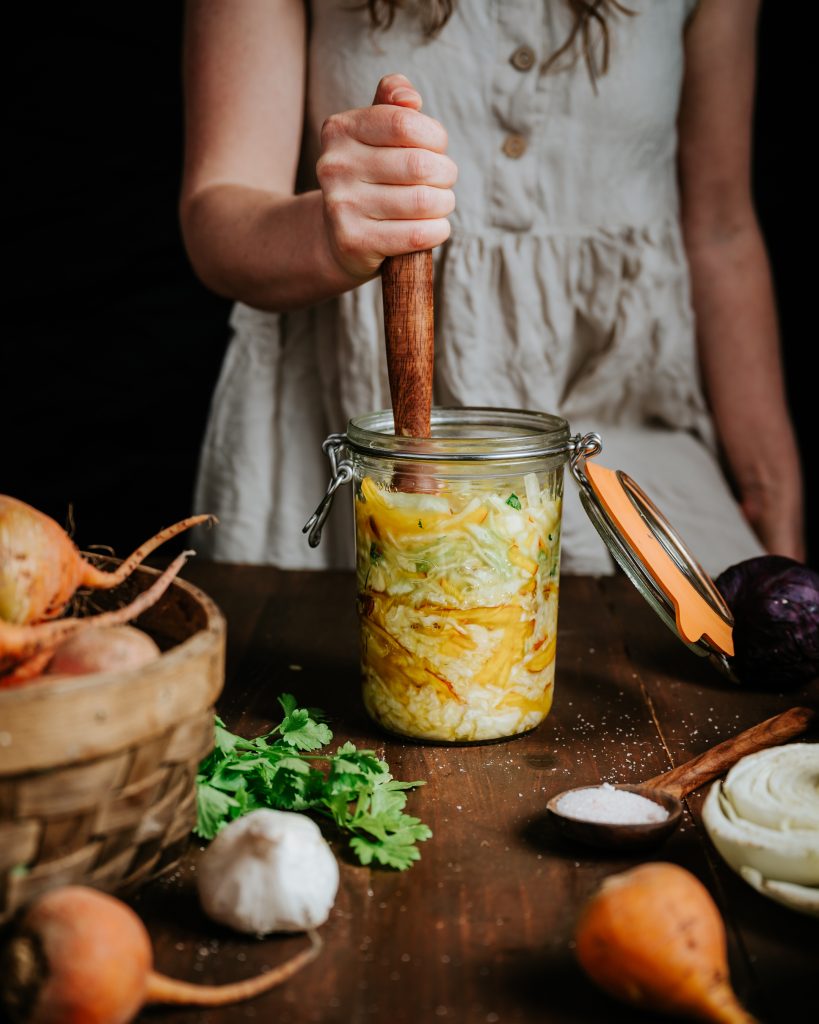
What Do I Need to Make Sauerkraut?
The beauty of making sauerkraut at home is that you only need a few basics to get started: cabbage, salt, and a container to ferment it in. The list below contains equipment that can be helpful for making sauerkraut. You most likely have all these in your kitchen already!
Fermentation container — The container can be a canning jar or a ceramic fermentation crock. For a typical large green cabbage, you will need 2-to-3-quart mason jars or 1 half gallon jar.
Fermentation weight — You will also need some kind of weight to keep the cabbage submerged in the brine during fermentation. You can buy glass fermentation weights or simply pasteurize rocks to get started.
I’ve used smooth river rocks as fermentation weights with no problems before I invested in glass weights. Pasteurize the rocks by boiling in water for at least 12 minutes before using.
A kitchen scale — A scale is useful to determine how much salt to add. The minimum amount of salt to use in lacto-fermentations is 2% of the weight or volume of the ingredients. That’s typically 2 teaspoons (11 g) of salt for 1 pound (454 g) of cabbage.
To find out how much salt to add, turn on the scale and set it to grams. Place an empty bowl on the scale. Tare the scale (reset to zero) and add the sliced cabbage. Take the weight and multiply it by 0.02. This gives you the amount of salt (in grams) to add.
Wooden cabbage pounder — Optional, but useful to pack the cabbage tightly into the jar to submerged it beneath the brine. If you don’t have a cabbage pounder, you can use your hand.
Canning funnel — A wide mouth funnel makes it easier to fill the jar without making a mess. If you ferment frequently or can, you will find yourself reaching for your canning funnel often!
Sharp knife and cutting board — For cutting the cabbage into thin strips.
Large mixing bowl — The bigger the better, so you can massage large amounts of cabbage with the salt.
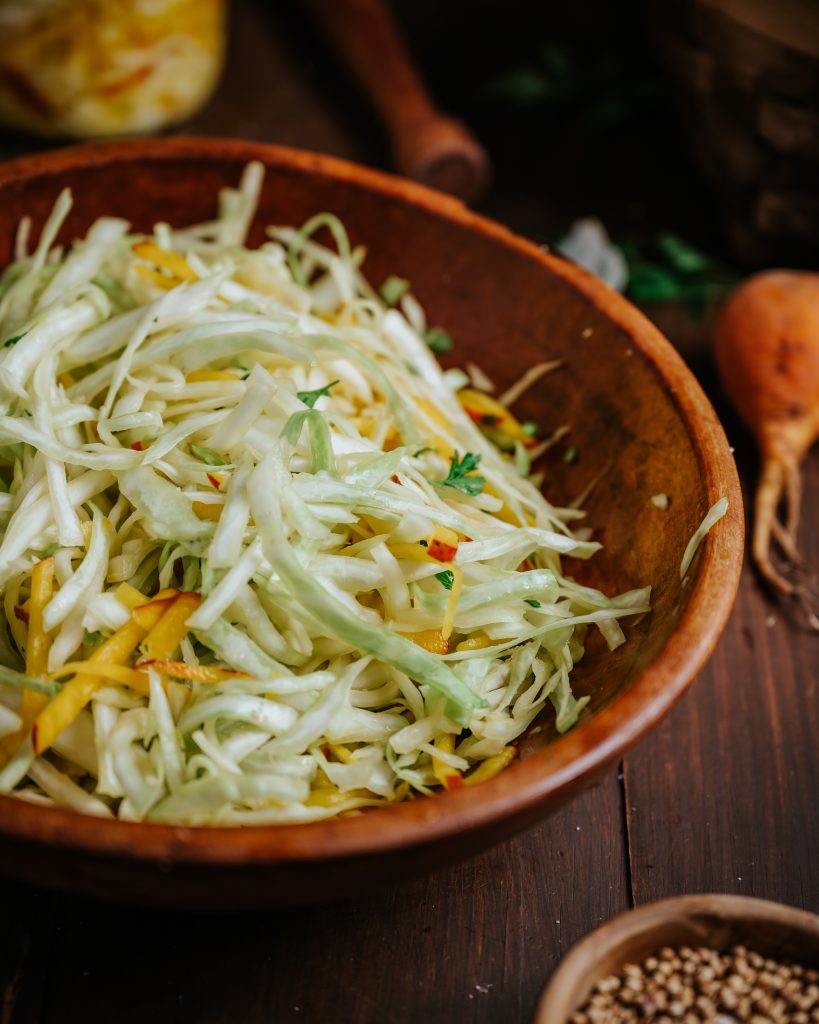
How Long Does It Take to Make Sauerkraut?
It takes about a week to ferment a small batch of sauerkraut, though the time greatly depends of the temperature and also the size of the batch you are making.
It will ferment faster at higher temperatures. The best quality sauerkraut is produced at a temperature range of 65-72° Fahrenheit (18–22° Celsius).
It’s important to remember that sauerkraut is safe to eat at every stage of the process, so there is no minimum or maximum fermentation time. It’s a matter of personal preference at what point you enjoy it.
Taste the sauerkraut after the initial fermentation of about 7 days. Some people let it ferment for 4 to 6 weeks to make it really sour. I prefer mine young and typically start eating it after 7 to 10 days.
Refrigerate it (or place in a cellar) when it tastes good to you, and it will keep for months.
How Long Does It Take to Make Sauerkraut?
It takes about a week to ferment a small batch of sauerkraut, though the time greatly depends of the temperature and also the size of the batch you are making.
It will ferment faster at higher temperatures. The best quality sauerkraut is produced at a temperature range of 65-72° Fahrenheit (18–22° Celsius).
It’s important to remember that sauerkraut is safe to eat at every stage of the process, so there is no minimum or maximum fermentation time. It’s a matter of personal preference at what point you enjoy it.
Taste the sauerkraut after the initial fermentation of about 7 days. Some people let it ferment for 4 to 6 weeks to make it really sour. I prefer mine young and typically start eating it after 7 to 10 days.
Refrigerate it (or place in a cellar) when it tastes good to you, and it will keep for months.
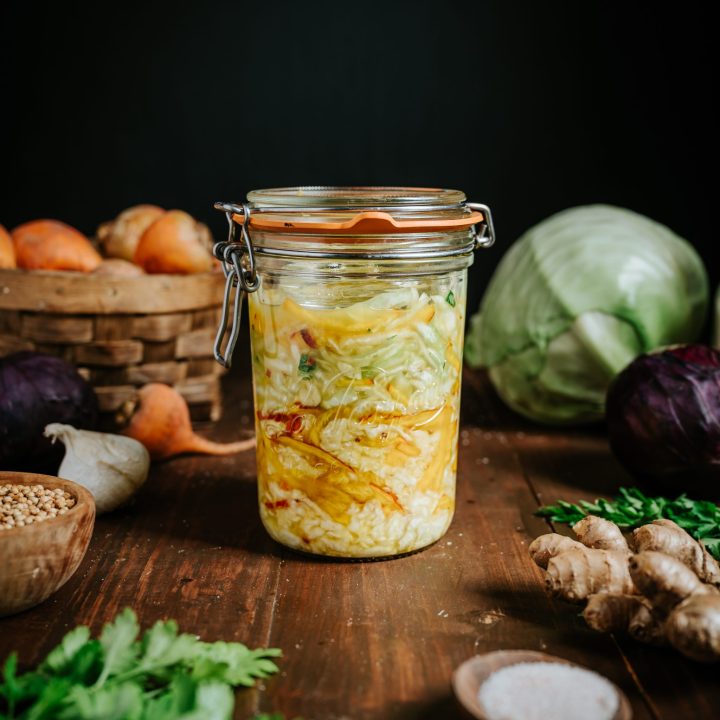
Homemade Sauerkraut
Lacto-fermented sauerkraut is one of the easiest fermented foods to make. All you need is cabbage, salt, and a jar to enjoy this delicious and healthy condiment loaded with probiotics!
Ingredients
- 1 large green cabbage
- Sea salt
Equipment
- Knife and cutting board
- Kitchen scale
- 1 quart canning jar with lid
- Fermentation weight
- Canning funnel (optional)
- Wood cabbage pounder (optional)
- Large mixing bowl
Instructions
- Remove the outer cabbage leaves and set aside at least one fresh one. You will use this leaf later to keep sauerkraut under the brine.
- Quarter the cabbage and remove the tough core in the middle if desired. Slice the cabbage into desired size strips.
- Place an empty bowl on a scale and tare the scale (reset to zero). Add the sliced cabbage to the bowl to calculate the weight. Multiply the weight of the cabbage by 0.02. This gives you the amount of salt to add (in grams).
- Add the appropriate amount of salt to the cabbage. Massage the salt into the cabbage with your hands until the cabbage starts to release its juices and becomes very watery. Keep massaging until the liquid drips out when you squeeze a handful.
- Use a canning funnel to fill the jar with the cabbage. Pack the cabbage in tightly, using a cabbage pounder or your hand to squeeze out the air pockets. The goal is to have the cabbage submerged under the brine with no air pockets.
- Pack the jar almost to the top, then place a clean folded cabbage leaf on to to press the cabbage beneath the brine.
- Place a fermentation weight or pasteurized rock on top of the cabbage leaf. Make sure the brine covers the cabbage. It's ok if the folded cabbage leaf is exposed to air, as you will discard it after the fermentation is finished.
- Cover the jar with the lid, but not too tightly so fermentation gases can escape. Place a piece of parchment paper under the lid if using a metal lid, to keep the lid from corroding. Place the jar in a bowl to catch drips.
- Ferment the sauerkraut for 7 to 10 days, then store in the fridge.
Notes
Fermented saurkraut will keep for months in the fridge.
Rerences:
No Comments